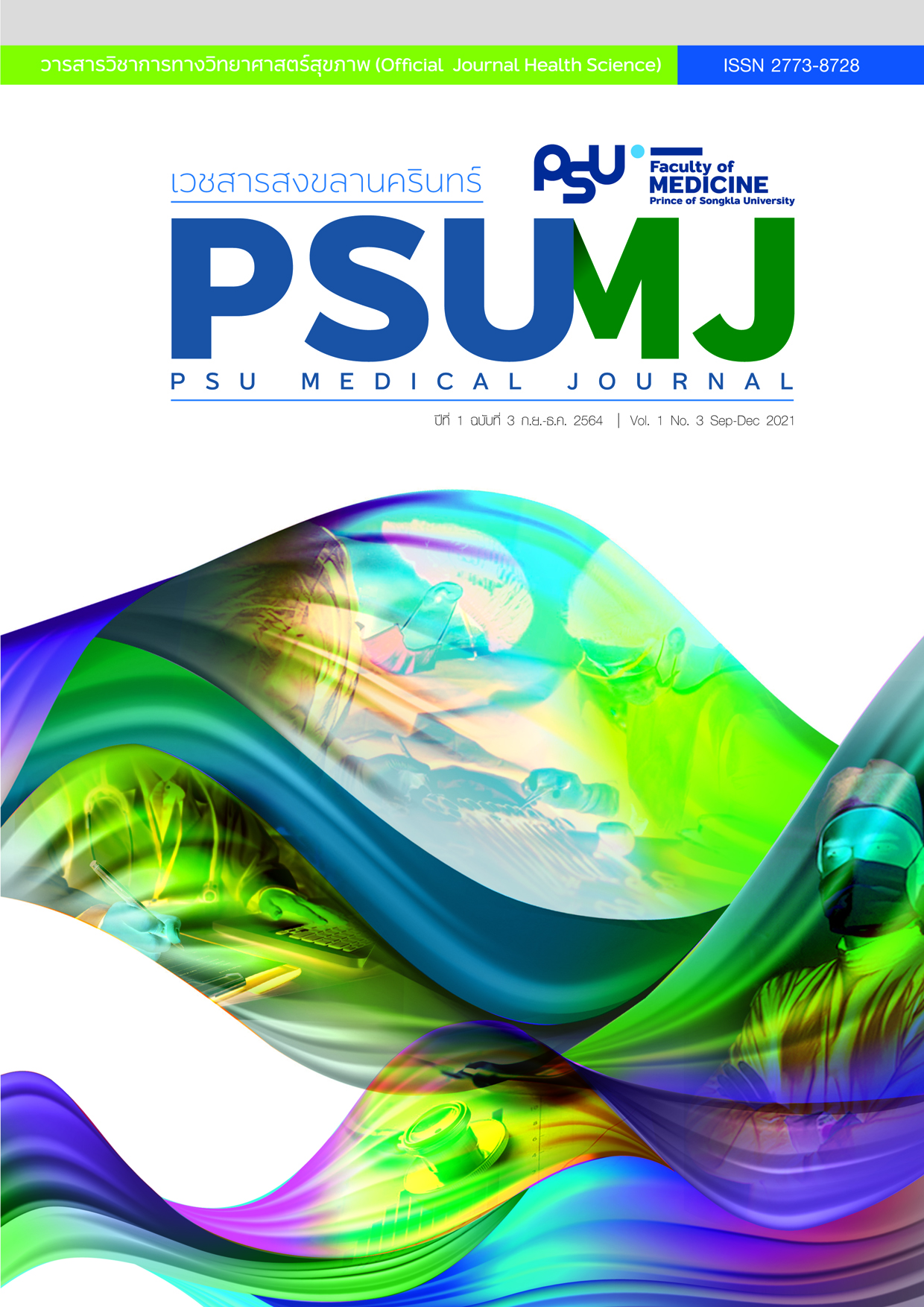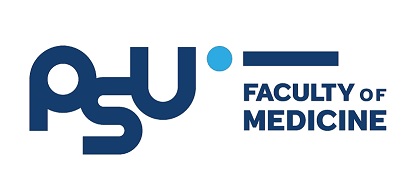Development of a Micro Computed Tomography Scanner for Localization of Lesions and Assessment of the Margin Width of Resected Breast Specimens in the Operating Room
Micro-computed Tomography for Breast Biosy Specimen
DOI:
https://doi.org/10.31584/psumj.2022247034Keywords:
Abnormal calcification, specimen radiography, CT scan of breast tissue specimenAbstract
Objective: The objective of this study was to develop a micro-computed tomography (micro-CT) scanner machine and software dedicated to the localization of calcification in resected breast tissue specimens in a 3-dimensional image. The micro-CT scanner was designed to be used as a mobile machine, particularly for use in the operating room.
Material and Methods: The system was designed to perform a 360-degree scan on a rotating table between the x-ray source and the detector sensor using a cone beam x-ray. The prototype was developed collaboratively between Prince of Songkla University (PSU) and the National Science and Technology Development Agency, Thailand (NSTDA). This was the first prototype for scanning specimens. The overall scan time and the image reconstruction was 5-10 minutes. The machine was tested for safety by PTEC (Electrical and Electronic Product Testing Center of NSTDA).
Results: The specification of MiniiScan® and preliminary results of 3D image reconstruction of the resected breast tissue specimen by using the MiniiScan® are present in this report. The study evaluated specimens form 31 patients obtained from June 2016 through January 2018. The average scan time was 10.4 minutes. The turnaround time of the conventional technique was 27.9 minutes. The quality of the 3D images as evaluated by PSU staffs was superior to the conventional x-ray images done with the standard mammogram. The 3D images can display the correct position of calcification and a width between calcification to margins in all directional plane.
Conclusion: The 3D images of the prototype intraoperative MiniiScan® scan were superior in quality to the standard mammogram, and had a quicker turnaround time for intraoperative application. Surgeons can use this machine in the operating room instead of relying on the conventional x-rays with a mammogram machine outside the operating theater.
References
Ferlay J, Colombet M, Soerjomataram I, Mathers C, Parkin DM, Piñeros M, et al. Estimating the global cancer incidence and mortality in 2018: GLOBOCAN sources and methods. Int J Cancer 2019;144:1941-53.
Chu KC, Tarone ER, Kessler GL, Ries LA, Hankey BF, Miller BA, et al. Recent trends in U.S. breast cancer incidence, survival, and mortality rates. J Natl Cancer Inst 1996;88:1571-9.
Hospital-based cancer registry annual report 2016. National Cancer Institute. Bangkok: Pornsup Printing; 2018.
Funk A, Heil J, Gomez C, Gomez C, Stieber A, Junkermann H, et al. Efficacy of intraoperative specimen radiography as margin assessment tool in breast conserving surgery. Breast Cancer Res Treat 2020;109:452-33.
McCormick JT, Keleher AJ, Tikhomirov VB, Budway RJ, Caushaj PF. Analysis of the use of specimen mammography in breast conservation therapy. Am J Surg 2004;188: 433–6.
Britton PD, Sonoda LI, Yamamoto AK. Breast surgical specimen radiographs: How reliable are they? Eur J Radio 2011;79: 245–9.
Ocal K, Dag A, Turkmenoglu O. Radioguided occult lesion localization versus wire guided localization for non-palpable breast lesions: randomized controlled trial. CLINICS 2011;66: 1003-7.
Bathla L, Harris A, Davey M. High resolution intra-operative two-dimensional specimen mammography and its impact on second operation for re-excision of positive margins pathology after breast conservation surgery. Am J Surg 2011;202:387– 94.
Cellini C, Huston TL Martins D, Christos P, Carson J, Kemper S, et al. Multiple re-excisions versus mastectomy in patients with persistent residual disease following breast conservative surgery. Am J Surg 2005;189: 662-6.
Dilon MF, Hill AD, Quinn CM, McDermott EW, O'Higgins N. A pathologic assessment of adequate margin status in breast conserving surgery. Ass Surg Oncol 2006;13:333-9.
Wallace AM, Daniel BL, Jeffrey SS, Birdwell RL, Nowels KW, Dirbaset FM, et al. Rates of re-excision for breast cancer after MRI guide wire localization. J Am Coll Surg 2005; 200:527-37.
Waljee JF, Hu ES, Newman LA, Alderman AK. Predictors of re-excision among women undergoing breast conserving surgery for cancer. Ann Surg Oncol 2008;15:1297-303.
Thongvigitmanee S, Narkbuakaew W, Aootaphao S, Jirattitichareon W , Siritanabodeekul S, Yampri P, et al, Simple Geometric Calibration for Scanner Misalignment in Cone- Beam Computed Tomography, Proc. of IEEE International Symposium on Biomedical Engineering, Bangkok: IEEE ISBME; 2009.
Jirattitichareon W, Sotthivirat S, Srinark T, Narkbuakaew W, Watcharabutsarakham S, Sinthupinyo W, et al, Optimization of 3D FDK Cone-Beam Reconstruction, Proc. of the 3rd International Symposium on Biomedical Engineering, Bangkok: ISBME; 2008;p.13-6.
Narkbuakaew W, Sotthivirat S, Gansawat D, Yampri P, Koonsanit K, Areeprayolkij W, et al. 3D Surface Reconstruction of Large Medical Data Using Marching Cubes in VTK,” Proc. of the 3rd International Symposium on Biomedical Engineering, Bangkok: ISBME; 2008;p.64-7.
Downloads
Published
How to Cite
Issue
Section
License
Copyright (c) 2021 Author and Journal

This work is licensed under a Creative Commons Attribution-NonCommercial-NoDerivatives 4.0 International License.








